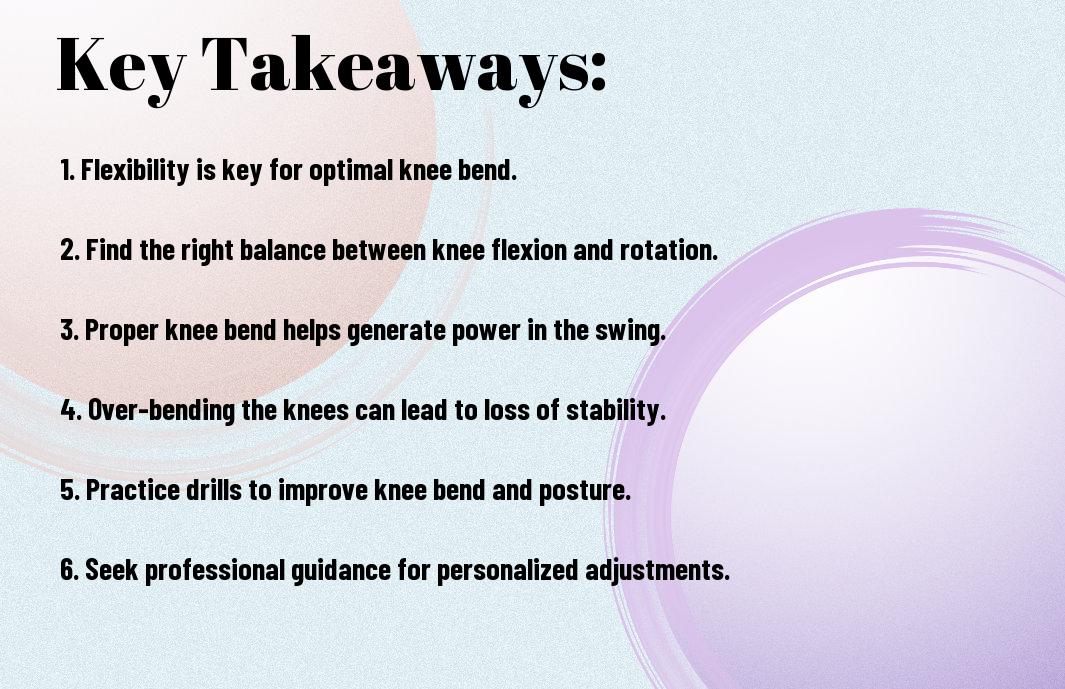Are you struggling to achieve the perfect knee bend in your golf swing? Understanding and optimizing your knee bend is crucial for achieving a powerful and accurate swing. Improper knee bend can lead to inconsistent shots and even injury if not addressed correctly. By focusing on your knee bend, you can improve your overall swing and take your game to the next level.
Optimizing your knee bend can result in a more stable base, allowing for a smoother and more powerful rotation through the ball. By maintaining the correct knee flexion, you can improve your balance and weight transfer, leading to longer and more accurate shots. In this blog post, we will discuss the importance of knee bend in your golf swing and provide some tips and exercises to help you optimize your knee flexion for a better swing.
Key Takeaways:
- Proper knee bend is crucial for generating power and stability in your golf swing. It allows you to transfer weight effectively and generate more clubhead speed.
- Flexibility and strength training can help improve your knee bend in the golf swing. Focus on exercises that target the quadriceps, hamstrings, and glutes to develop a more stable and reliable base.
- Seek professional guidance to ensure that you are optimizing your knee bend in the golf swing. A golf instructor can pinpoint any swing faults and provide personalized drills and tips to improve your technique.
Anatomy of the Golf Swing
Obviously, understanding the anatomy of the golf swing is crucial to optimizing your knee bend. The golf swing is a complex movement that involves the entire body, but the role of the lower body, in particular, the knees, is often underestimated. To maximize power and accuracy in your swing, it is essential to have a thorough understanding of how the body moves during the swing and the specific role that the knees play in this motion.
Breakdown of a Traditional Swing
When you break down a traditional golf swing, you can see the importance of the knees in generating power and stability. As you address the ball, your knees should be slightly flexed, providing a solid base for your swing. As you rotate your body back and then through the ball, your knees act as a stabilizing force, transferring energy from your lower body to the club. The proper sequence of knee movement in the swing is crucial for generating the maximum amount of power and maintaining your balance throughout the swing.
Role of the Knees in Swing Motion
The role of the knees in the golf swing cannot be overstated. Your knees act as the connection point between the ground and your upper body, creating a stable and powerful foundation for your swing. When you initiate the downswing, your knees play a vital role in transferring the energy you’ve generated from your lower body to the club, allowing you to deliver maximum power to the ball. Additionally, the position and movement of your knees can directly influence the path of your club, affecting the accuracy of your shot. By maintaining proper knee flexion and rotation throughout the swing, you can significantly improve the consistency and distance of your shots.
Mechanics of Knee Bend in Golf Swing
Some of the most crucial aspects of a successful golf swing lie in the mechanics of your knee bend. The way you utilize your knee flexion and extension can significantly impact the power and accuracy of your swing. To optimize your knee bend, it’s important to understand the weight distribution, the impact of knee bend on swing path, and the overall mechanics involved.
Understanding Weight Distribution
When it comes to knee bend in your golf swing, understanding weight distribution is key. Proper weight transfer is essential for generating power and maintaining balance throughout the swing. As you initiate your backswing, the majority of your weight should be over your right leg (if you are a right-handed golfer). This will allow you to properly load up the back leg, creating potential energy that can be unleashed as you transition into the downswing. As you transition, your weight should shift smoothly onto your left leg, allowing you to drive through the ball with maximum force. Understanding and mastering this weight transfer is crucial for optimizing your knee bend and generating the power you need for an effective swing.
Impact of Knee Bend on Swing Path
The way you utilize your knee bend also has a significant impact on your swing path. Your knee bend can influence the plane of your swing and the angle of attack, ultimately determining the trajectory and direction of your shots. Proper knee bend can help you maintain a stable lower body and allow for a smoother, more consistent swing path. On the other hand, inadequate knee bend can lead to instability and inconsistency in your swing. Having the right degree of knee flexion and extension throughout your swing is crucial for maintaining control and accuracy.
A well-timed and coordinated knee bend throughout your swing can enhance your overall performance on the golf course. By understanding these mechanics and making the necessary adjustments to optimize your knee bend, you can take your game to the next level and achieve more consistent, powerful, and accurate shots.
Importance of Flexibility and Strength for Optimal Knee Bend
However, to achieve optimal knee bend in your golf swing, it is important to focus on both flexibility and strength in your lower body. Flexibility allows you to achieve the proper range of motion in your knees, while strength helps maintain stability and power throughout the swing. Neglecting either of these aspects can lead to decreased performance and potential injury.
The Role of Flexibility in Creating Proper Knee Bend
Flexibility plays a crucial role in creating the proper knee bend in your golf swing. Having good flexibility in your lower body allows you to achieve the necessary range of motion in your knees, which is essential for generating power and maintaining balance throughout your swing. Without adequate flexibility, you may struggle to bend your knees to the ideal angle, resulting in a restricted and inefficient swing. It can also increase the risk of strain or injury as your body compensates for the lack of flexibility in other areas.
Importance of Knee Strength in Maintaining Stability and Power
Strong knees are integral to maintaining stability and power in your golf swing. Having sufficient strength in your lower body, specifically in the muscles surrounding your knees, helps prevent buckling or collapsing during your swing, allowing for a more consistent and controlled movement. Additionally, strong knees help you generate more power and drive through the ball, contributing to greater distance and accuracy in your shots. Without adequate knee strength, you may compromise your stability and control, leading to a less effective and potentially injury-prone swing.
Correct Posture and Alignment for Knee Bend
Now, when it comes to optimizing the knee bend in your golf swing, correct posture and alignment are crucial. Your posture should be balanced and athletic, with a slight flex in your knees. For a more in-depth look on how much you should bend your knees when setting up your golf swing, check out this helpful Quora post How much should you bend your knees when setting up ….
Positioning of the Feet and Legs
When setting up for your golf swing, make sure your feet are shoulder-width apart, with your weight evenly distributed between them. Your knees should be slightly flexed, allowing for mobility and stability as you move through your swing. Your legs should feel engaged and ready to drive the power of your swing.
Usual Mistakes in Swing Posture
One common mistake in golf swing posture is locking your knees or bending them too much. Both of these mistakes can hinder your ability to generate power and control in your swing. It’s important to find the balance that allows for flexibility and stability in your lower body. Another mistake is allowing your posture to collapse during the swing, leading to inconsistency and potential injury. Keep a strong and steady posture throughout your swing for optimal performance.
Techniques to Optimize Knee Bend during Golf Swing
Despite being often overlooked, the proper knee bend is crucial for an effective and powerful golf swing. Your knee bend not only affects your posture and balance, but it also plays a significant role in generating power and accuracy. To optimize your knee bend during your golf swing, there are several key techniques to keep in mind.
Exercises to Improve Your Knee Bend
To improve your knee bend during your golf swing, incorporating specific exercises into your fitness routine can be highly beneficial. Work on strengthening your quadriceps, hamstrings, and glutes to help better support your knee bend during the swing. Additionally, incorporating flexibility exercises for your hip flexors and hamstrings can help you achieve a more fluid and efficient knee bend during your swing. A combination of strength and flexibility training will ultimately contribute to a more powerful and stable golf swing.
Adaptation of the Swing to Individual Physical Characteristics
It’s essential to recognize that each golfer has unique physical characteristics and limitations that can impact their ability to optimize knee bend during the swing. Factors such as height, flexibility, and existing injuries can all influence the ideal knee bend for each individual. Therefore, it’s crucial to adapt your swing to accommodate these physical characteristics. Your stance width, ball position, and even the angle of your spine can all be adjusted to optimize your knee bend and overall swing mechanics. By recognizing and adapting to your individual physical characteristics, you can maximize the effectiveness of your knee bend and improve your overall performance on the golf course.
Impact of Optimized Knee Bend on Performance
After optimizing your knee bend in your golf swing, you will notice a significant impact on your overall performance on the green. The correct knee bend not only affects your swing power and speed, but also has a direct influence on the trajectory of the ball, ultimately affecting your game.
Evaluation of Swing Power and Speed
By optimizing your knee bend, you are able to generate more power and speed in your swing. The correct knee bend allows for a more stable base, enabling you to use your lower body to drive the club through the ball, resulting in a more powerful and faster swing. This increase in power and speed translates to longer distances and more accuracy with your shots. In addition, the correct knee bend helps to maintain balance throughout the swing, helping you to stay on target and prevent mishits.
Influence of Knee Bend on Ball Trajectory
Your knee bend directly influences the trajectory of the ball. With the proper knee bend, you are able to maintain a consistent angle of attack, which impacts how the ball launches off the clubface. Optimized knee bend allows for a more consistent and controlled delivery of the club to the ball, resulting in a more predictable ball flight. This can lead to more accurate shots and better overall performance on the course. Incorrect knee bend can cause the club to bottom out too early, leading to topped or fat shots, and ultimately hindering your game.
Remember, the correct knee bend in your golf swing is crucial for maximizing your performance on the course. By evaluating and understanding the impact of optimized knee bend on your swing power, speed, and ball trajectory, you can make the necessary adjustments to improve your overall game. Proper knee bend allows you to generate more power and speed, while also influencing the trajectory of the ball, leading to more consistent and accurate shots. By focusing on optimizing your knee bend, you can take your golf game to the next level and achieve better results on the green.

Conclusion: Optimizing Knee Bend in Your Golf Swing
Conclusively, mastering the optimal knee bend in your golf swing is crucial for achieving consistency and power in your shots. By understanding the impact of proper knee flexion on your swing, you can improve your stability, balance, and control throughout the entire motion. Additionally, it allows you to generate more power and speed, leading to longer and more accurate shots.
Remember to maintain a slight knee bend throughout your swing, resisting the urge to straighten or lock your knees as you follow through. This will help you stay balanced and connected to the ground, ensuring a smooth and effective transfer of energy from your body to the club. By continuously practicing and refining your knee bend, you can enhance your overall performance on the golf course and achieve a more efficient, powerful swing.
FAQ
Q: What is the importance of optimizing knee bend in a golf swing?
A: Optimizing knee bend in your golf swing is crucial for generating power and control. Proper knee bend helps to transfer energy from the lower body to the upper body, allowing for a more efficient and powerful swing. It also provides stability and balance throughout the swing, reducing the risk of injury.
Q: How can I optimize my knee bend in my golf swing?
A: To optimize your knee bend in your golf swing, start by addressing your stance. Your knees should be slightly flexed at address, with your weight evenly distributed between both feet. As you take the club back, maintain a stable and balanced knee bend, allowing for a smooth transition into the downswing. Avoid excessively straightening or locking your knees during the swing, and focus on maintaining a consistent and comfortable bend throughout the entire motion.
Q: What are common mistakes to avoid when it comes to knee bend in a golf swing?
A: One common mistake to avoid is locking the knees at any point in the swing. This can limit your ability to rotate and generate power, leading to a weaker and less controlled swing. Additionally, allowing the knees to collapse inward during the swing can result in loss of stability and balance. It’s important to maintain proper knee alignment and stability throughout the entire golf swing to optimize performance and reduce the risk of injury.
Hey, I'm Maxwell Fairway, a name that's been echoing on golf courses for over a decade. Golf has been my driving force, propelling me through the world of fairways and greens since my early days. With each swing, I've crafted my skills, refined my approach, and gained invaluable wisdom about this captivating sport.






